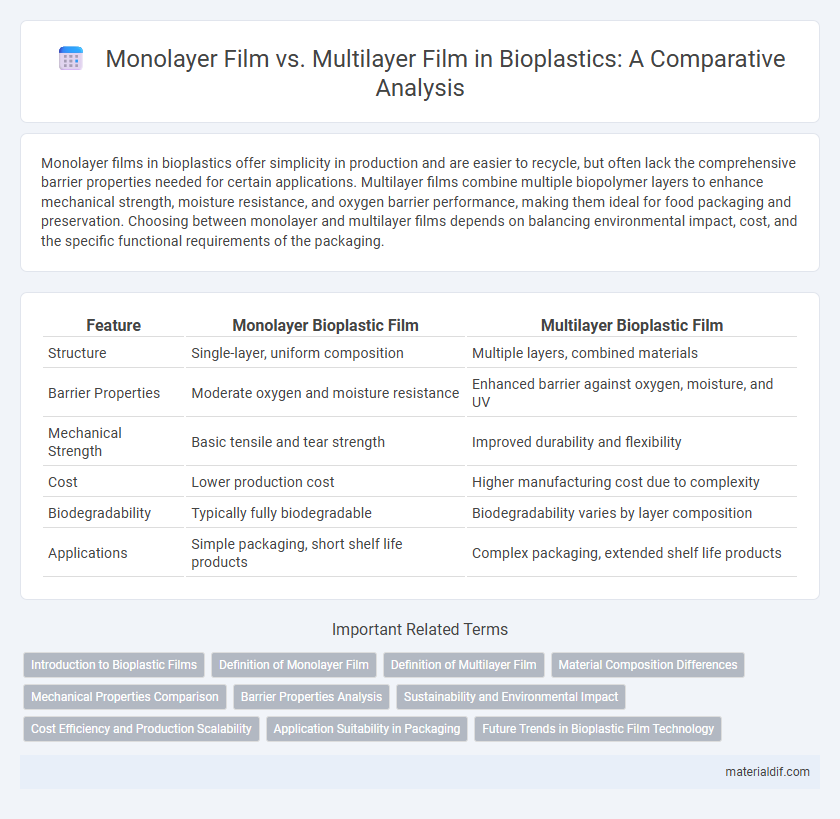Monolayer films in bioplastics offer simplicity in production and are easier to recycle, but often lack the comprehensive barrier properties needed for certain applications. Multilayer films combine multiple biopolymer layers to enhance mechanical strength, moisture resistance, and oxygen barrier performance, making them ideal for food packaging and preservation. Choosing between monolayer and multilayer films depends on balancing environmental impact, cost, and the specific functional requirements of the packaging.
Table of Comparison
| Feature | Monolayer Bioplastic Film | Multilayer Bioplastic Film |
|---|---|---|
| Structure | Single-layer, uniform composition | Multiple layers, combined materials |
| Barrier Properties | Moderate oxygen and moisture resistance | Enhanced barrier against oxygen, moisture, and UV |
| Mechanical Strength | Basic tensile and tear strength | Improved durability and flexibility |
| Cost | Lower production cost | Higher manufacturing cost due to complexity |
| Biodegradability | Typically fully biodegradable | Biodegradability varies by layer composition |
| Applications | Simple packaging, short shelf life products | Complex packaging, extended shelf life products |
Introduction to Bioplastic Films
Bioplastic films are eco-friendly alternatives to conventional plastic films, derived from renewable biomass sources such as corn starch, sugarcane, and cellulose. Monolayer bioplastic films consist of a single homogeneous layer, offering simplicity and ease of recycling, but often lacking advanced barrier properties. Multilayer bioplastic films combine two or more layers of different biopolymer materials, enhancing mechanical strength, moisture resistance, and gas barrier performance for diverse packaging applications.
Definition of Monolayer Film
Monolayer film is a single-layer bioplastic film composed of one homogeneous material, designed to provide basic barrier properties such as moisture resistance and mechanical strength. It offers simplicity in manufacturing and recyclability compared to multilayer films, which combine different materials to enhance functionality. Monolayer bioplastic films are commonly used in packaging applications where moderate protection and biodegradability are required.
Definition of Multilayer Film
Multilayer films in bioplastics consist of multiple layers of different polymer materials laminated together to enhance mechanical strength, barrier properties, and overall performance compared to monolayer films. Each layer in a multilayer film serves a specific function such as moisture resistance, gas barrier, or heat sealability, optimizing the film for various packaging applications. The combination of biodegradable or compostable polymers in multilayer structures enables tailored properties while maintaining environmental sustainability.
Material Composition Differences
Monolayer bioplastic films consist of a single polymer layer, typically made from materials like polylactic acid (PLA) or polyhydroxyalkanoates (PHA), offering basic barrier properties and biodegradability. Multilayer bioplastic films combine different polymers such as PLA, starch-based blends, and polybutylene succinate (PBS) in multiple layers to optimize mechanical strength, moisture resistance, and oxygen barrier performance. The material composition differences directly impact the films' functional properties, with multilayer structures providing enhanced protection and versatility in packaging applications compared to monolayer films.
Mechanical Properties Comparison
Monolayer bioplastic films typically offer moderate mechanical strength and flexibility, making them suitable for lightweight packaging applications. Multilayer bioplastic films enhance mechanical properties by combining different polymer layers, resulting in superior tensile strength, puncture resistance, and barrier performance. The multilayer structure improves durability and extends product shelf life, outperforming monolayer films in demanding packaging environments.
Barrier Properties Analysis
Monolayer bioplastic films typically offer limited barrier properties, making them less effective against moisture and oxygen penetration compared to multilayer films. Multilayer bioplastic films enhance barrier performance by combining materials with complementary characteristics, significantly reducing gas and vapor transmission rates. This multilayer structure optimizes shelf life and product protection, which is crucial in food packaging applications.
Sustainability and Environmental Impact
Monolayer bioplastic films offer easier recyclability and lower energy consumption in production, enhancing sustainability by reducing waste and carbon footprint. Multilayer films provide superior barrier properties and durability but pose challenges in recycling due to mixed material layers, often leading to landfill accumulation. Optimizing multilayer structures with compatible biopolymers can mitigate environmental impact while maintaining functional performance.
Cost Efficiency and Production Scalability
Monolayer films in bioplastics generally offer lower production costs and simpler manufacturing processes, enhancing cost efficiency for large-scale production. Multilayer films provide superior barrier properties but require more complex and expensive production methods, which can limit scalability and increase overall costs. Choosing between monolayer and multilayer bioplastic films depends on balancing cost efficiency with functional performance needs in packaging applications.
Application Suitability in Packaging
Monolayer bioplastic films offer simplicity and cost-effectiveness, making them suitable for packaging applications with minimal barrier requirements such as fresh produce or dry goods. Multilayer bioplastic films, combining layers with distinct properties, provide enhanced mechanical strength and superior barrier protection against moisture, oxygen, and odors, ideal for high-performance food packaging. Industries favor multilayer films for extending shelf life and preserving packaging integrity in complex product environments.
Future Trends in Bioplastic Film Technology
Monolayer bioplastic films offer simplicity and ease of recycling but often lack the barrier properties required for advanced packaging applications. Multilayer bioplastic films incorporate diverse biodegradable polymers to enhance mechanical strength, barrier resistance, and functional performance, aligning with the demand for sustainable packaging solutions. Future trends emphasize the development of fully compostable multilayer films using innovative polymer blends and bio-based additives to achieve scalable, eco-friendly alternatives that meet regulatory standards and circular economy goals.
Monolayer film vs Multilayer film Infographic

 materialdif.com
materialdif.com